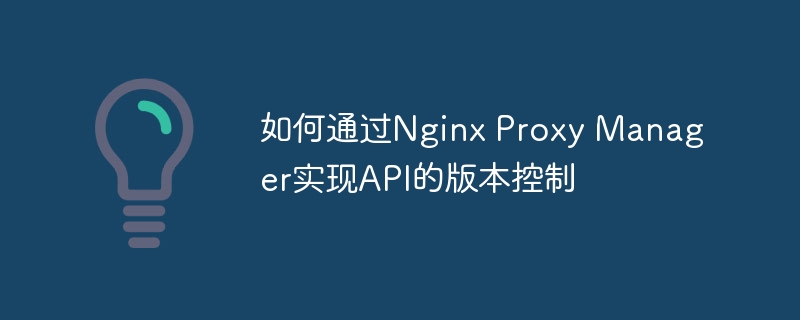Home >Operation and Maintenance >Nginx >How to implement API version control through Nginx Proxy Manager
How to implement API version control through Nginx Proxy Manager
- PHPzOriginal
- 2023-09-26 21:34:491602browse

How to implement API version control through Nginx Proxy Manager requires specific code examples
With the continuous iteration and upgrade of software development, API version control becomes more and more is becoming more and more important. In actual development, we often need to provide correct routing and access control for different versions of APIs. Nginx Proxy Manager is a powerful proxy server that can flexibly handle HTTP requests and forward them to different backend services. This article will introduce how to use Nginx Proxy Manager to implement API version control and provide specific code examples.
First, we need to install and configure Nginx Proxy Manager. This assumes that the Nginx Proxy Manager has been successfully installed and the correct reverse proxy settings are configured. Next, we need to create a new proxy host and set the correct domain name.
Suppose we have a domain name called "api.example.com" and we want to provide different routes for different versions of the API. To do this, we can create two backend services in the Nginx Proxy Manager, one for the v1 version of the API and the other for the v2 version of the API.
First, in the Nginx Proxy Manager interface, click the "Proxy Hosts" tab and click the "Add Proxy Host" button. In the pop-up interface, fill in the relevant information. For example, we can fill in "api.example.com" in the domain name field and select "HTTP" as the protocol. Then, in the "Upstreams" field under "Proxy Upstreams", click the "Add Upstream" button to create a new backend service.
For the v1 version of the API, we can fill in "v1.example.com" in the domain name field and select the appropriate protocol. For the v2 version of the API, we can fill in "v2.example.com" in the domain name field and select the appropriate protocol.
Next, we need to configure routing rules to correctly forward requests to different backend services. Click on the proxy host you just created, and click the "Server Block" tab in the pop-up interface. In the "Routing" field, click the "Add Route" button to add routing rules.
For the v1 version of the API, we can fill in "/v1" in the path field and select the v1 backend service we just created. For the v2 version of the API, we can fill in "/v2" in the path field and select the v2 backend service we just created.
At this point, we have successfully configured API version control. When the client sends a request to "api.example.com/v1/...", the request will be forwarded to the v1 version of the backend service. Similarly, when the client sends a request to "api.example.com/v2/...", the request will be forwarded to the v2 version of the backend service.
The following is a simple sample code that shows how to implement a simple API in Node.js and use Nginx Proxy Manager for version control. Suppose we have a file named "app.js" that contains the following code:
const express = require('express');
const app = express();
app.get('/v1/hello', (req, res) => {
res.send('Hello from v1 API');
});
app.get('/v2/hello', (req, res) => {
res.send('Hello from v2 API');
});
app.listen(3000, () => {
console.log('Server running on port 3000');
});In the Nginx Proxy Manager, we can run "app.js" on the local 3000 port and create Proper reverse proxy settings.
This is just a simple example, the actual API may be more complex. But with the version control feature of Nginx Proxy Manager, we can easily handle different versions of the API and provide correct routing and access control.
In summary, through Nginx Proxy Manager, we can easily implement API version control. We just need to create different versions of the backend service and configure the correct routing rules. I hope the code examples in this article are helpful!
The above is the detailed content of How to implement API version control through Nginx Proxy Manager. For more information, please follow other related articles on the PHP Chinese website!

